#Bonaparte’s Gull
Explore tagged Tumblr posts
Text

Whole flock of Bonaparte’s Gulls
#Bonaparte’s gull#gull#nature#vancouver island#nature photography#pnw#birds#birding#bird photography#birdwatching#original photography on tumblr#original photography
427 notes
·
View notes
Text
The State Birds Initiative: Pennsylvania (#2)

Welcome to the second official poll of the State Birds Initiative! Before the poll, though, one thing real quick. My suggestion is that you read the post below before voting in the poll below. That's especially important if you're lacking any context about the birds being presented as the new (or old) State Bird of the Keystone State, Pennsylvania. This is to be fully informed as to why these are being presented, and to make your choices appropriately. Lastly, some of these birds, you will notice, may go against some of the rules listed in the introduction post. All is explained after the jump where the explanations are, I promise you that. But with that...OK! Here's the poll! More choices this time, but that's definitely a bit deceptive. Trust me, read the stuff after the jump, you'll see why.

LET'S GO PHILLY
Kidding on two fronts. One, not a massive sports fan, and not really a fan of any Philadelphia teams (I love Gritty, though. Always and forever.). And two, this is obviously not a post about Philadelphia. So, let's talk about the Quaker State, Pennsylvania! The capital is Harrisburg, while its biggest city is Philadelphia. Pennsylvania is, of course, the first capital of these United States, and arguably the seat of the country. It's the home of Benjamin Franklin (even though it wasn't his birthplace), the Liberty Bell, the Constitution, and Rocky Balboa. And of course, its perfect symbol: Gritty.

God, he's beautiful. The perfect mascot. Who cares about the Flyers; Gritty's who I'm rooting for. Anyway, amazing and unassailable symbols of chaos aside, we're here to talk about Pennsylvania's natural world. So, what are we looking at. Well, it's a mostly deciduous forest-dominated state, so we're looking at seasonal forests and probably seasonal birds...for the most part. At the very least, our ideal bird is a forest resident and breeder in the state. Nothing too unusual or difficult to find.
Birding in Pennsylvania is pretty stereotypical to that of the northeastern United States. There are a few major spots, especially those that graze the Appalachian Mountain Range, which runs through the state. As for conservation concern, habitats of focus are the Appalachian forests that are often deforested for development, especially in the areas near Philadelphia. No real surprise, but that's a good target for conservation focus.

As for Pennsylvania's culture, it's famously descendant of the Quakers, who founded the state under the leadership of William Penn. This isn't to say that Pennsylvanians are Quakers; if you've been to Philadelphia, you know that's not true. According to a few accounts I've seen, that essentially means there's an attitude of helpfulness to your neighbor within the state, as well as a cultivation of the value of hard work. It's also a state that prides its history pretty thoroughly, from Philadelphia's various museums and public historical monuments, to the historical communities that thrive in the state, like the Lancaster Amish. Not sure how either of those will translate themselves into birds, but...hey, we'll see, right?
I also saw somebody refer to PA as heavily into "snack culture". And I'm not entirely sure what that means, but I WILL take the opportunity to say one thing: do not waste money on the cheesesteaks at Pat's or Geno's. It's meant to attract tourists, and they aren't worth it, BELIEVE ME. There are better cheesesteaks in the city, from what I've heard, but those two are...not worth the money. Just trust me on this one.

That said, it's time to look for a proper state bird for Pennsylvania. There's some emphasis there on the "proper", and the first entry in the following section has an explanation by that. With that, let's go for it! State Bird nominations for Pennsylvania below the jump!

Ruffed Grouse (Bonasa umbellus)
OK, let's start with the current bird highlighted by Pennsylvania, the Ruffed Grouse (Bonasa umbellus). Now, I love these guys. If you've never experienced it, walking through the woods and suddenly hearing a deep thrumming echo through the trees is...it's a unique sensation. You wonder where it's coming from, why and how it's so loud, what's making it, and then...it just pops up. Maybe it sees you looking for it, and you flush it out and watch a panicking male run away. Maybe he just looks back at you puffed up and stands his ground a bit (which is unlikely, but still). Either way, these guys never cease to put a smile on my face.
This behavior is called drumming, by the way, as pictured above. A male grouse will position themselves on a hollow fallen tree, and use it as a megaphone to send out these vibrations across swathes of territory. It is, unsurprisingly, a territorial behavior for the grouse, and iconic in its own way. Now, a few more facts about the Ruffed Grouse. The name, by the way, comes from the feathers on the sides of the male's neck, which are erected during courtship and territorial displays. It's obviously colored to camouflage in the fallen leaves of deciduous forests, where it resides throughout the year. They're granivorous members of the Galliformes (grouse, pheasants, quail, etc.), and fairly common in the Eastern United States. But with that said...here's the big problem with this choice for State Bird.
It isn't a State Bird. It's a State Game Bird.

Yeah, remember the Delaware Blue Hen from the last poll (assuming you read it, here it is if you didn't)? I suggested that it should be the State Game Bird of Delaware, rather than the State Bird. Well, right next door to Delaware, Pennsylvania already has a State Game Bird in the form of the Ruffed Grouse. Why, you ask? Well, first off, the Ruffed Grouse is actuall known as the "King of the Gamebirds" colloquially, crowned such by William Harnden Foster, the father of skeet shooting. Yes, actually. But anyway, the bird was declared the State Game Bird in 1931, but there was not real reason why outside of popularity with hunters. So...OK, fair enough. It just means that the Ruffed Grouse is not a State Bird. But should it be?
The question asked here is, should the Ruffed Grouse be promoted to a State Bird, since most Pennsylvanians seem to think of it as such anyway? Well, looking at the guidelines we've previously set and established...I don't know, honestly. And my main reason for doubt, personally, is the fact that the grouse, while found in Pennsylvania, is BARELY a breeder in the state. Only 0.4% of the bird's overall breeding population is in Pennsylvania, and only 13% is in the United States at all. And yes, that means the species is mostly found in...

So, when you think about it, is this truly the answer to the PA State Bird question? Well, it does represent much of the biome of Pennsylvania, a forest-dominated state squarely in the temperate and deciduous zone. It has a history and culture of hunting, and the grouse is certainly one of the most popular species on that front. And they're certainly iconic, and easy to hear in most forests, not to mention fun to look and listen for for beginning birders. The first time I stumbled on a Ruffed Grouse was, lemme tell you, a delight. And the second time, I LITERALLY stumbled on them, because a mother and her chicks were running away from me, and one of the chicks ran between my feet from behind me to join its mother, and I have NEVER BEFORE FELT MORE LIKE A DISNEY PRINCESS UNTIL THAT MOMENT IT WAS FUCKING MAGICAL
But, yeah, with that said, I submit the Ruffed Grouse for your deliberation as a State Bird. And as for a State Game Bird...oh, I've got a thought on that one, too. But I'll save that until the end, I think.

Scarlet Tanager (Piranga olivaceus)
So, as before, let's start the replacement options with a bird suggested by the Cornell Lab of Ornithology, and a solid-ass pick for a number of reasons. The Scarlet Tanager is one of the most striking birds in the eastern United States, and there's no state with a larger breeding population of these birds than Pennsylvania. 13% of the species' global breeding population is found in PA, making the state a major staging point for the species. Native to and dependent upon the deciduous forests of the state, this is a hidden ornithological icon.

Chestnut-sided Warbler (Setophaga pensylvanica)
Well, if I had the Ring-billed Gull (Larus delawarensis) listed for Delaware, it only makes sense to list the Chestnut-sided Warbler (Setophaga pensylvanica) for Pennsylvania! Similarly, it's the only species that have Pennsylvania as a state in the species name. And trust me, this is a rare luxury, either because most states have no bird species named for them, or a LOT of bird species named for them. Just wait for the Carolinas or California, believe me. But that said, is the Chestnut-sided Warbler a good fit for Pennsylvania?
Well, it certainly breeds in the state; the majority of the global population breeds in Canada, like the Ruffed Grouse, but a good amount still breeds in the deciduous temperate forests of the USA. The PA breeding population represents 3% of the global breeding population, and as compared to Michigan's 7%, Pennsylvania still doesn't have the majority. But again, let's put that statistic to the wayside. Is there anything else about the Chestnut-sided Warbler that represents Pennsylvania in a meaningful way? Well...no. Not, not really. There is a story of John James Audubon (yes, that Audubon, the racist one), and his first AND ONLY sighting of the Chestnut-sided Warbler, which took place in eastern Pennsylvania, alongside his hunt for the species throughout his life. So, hey, there's a tie. But other than that, this is another opportunity to choose an handsome looking bird that serves as a unique bird to look for for Pennsylvanians, any of whom can say, "Hey, I've seen that bird! Cool!"
...Wait, I just realized something about this category of choice. Pennsylvania has more species name reputation than I thought...indirectly. Hmm. Let's combine their entries.

Philadelphia Vireo (Vireo philadelphicus) Bonaparte's Gull (Chroicocephalus philadelphia) Mourning Warbler (Geothlypis philadelphia)
There are, in total, three species that are named after the great city of Philadelphia, Pennsylvania. And this is both the only one with the city name in its common name...and also the worst choice of the three. At least the Bonaparte's Gull (Chroicocephalus philadelphia) and the Mourning Warbler (Geothlypis philadelphia) breed in the state. And for the record, those are up for debate for this spot if anybody world prefer those go in there. But if those are better options (barely; both birds also barely breed in Pennsylvania), then why choose the Philadelphia Vireo?

Is it iconic? To birdwatchers, maybe, but mostly because it's a pretty difficult bird to get when you're starting out. I've seen them, but it's not easy to find them. And to the layman? It's a little green bird that lives in green trees. Oof. Hard sell for a state bird. At least Bonaparte's Gull (above) is visible on bodies of water, and a fairly common bird alongside being an unusual-looking gull for most people. Plus, hey, they're kinda handsome and cute in my opinion. What about the Mourning Warbler (below)? While also somewhat difficult to find by virtue of being a little green bird, has a notable and memorable appearance. But you could also argue that it belongs rightly to other states instead.

But the Philadelphia Vireo? Yeah, it's the worst candidate of the three, but...it's also the only warbler who once carried the name Brotherly-Love Vireo. Yeah. As in Philadelphia, the City of Brotherly Love? That is a good reason. However, you could argue that, given the fact that the work "philadelphia" is literally Greek for "brotherly love"...it's still a flimsy argument. But hey, I'd be remiss if I didn't include these guys on this list for State Bird, even if I...doubt they're gonna get any votes.

Pileated Woodpecker (Dryocopus pileatus)
For one of two conservation-related entries of this post, let's take a look at the Pileated Woodpecker (Dryocopus pileatus). Now, to get this out of the way, the Pileated Woodpecker is all over the Eastern USA. These big, crow-sized woodpeckers (and these guys are HUGE when you see them for the first time; love 'em) are a common sight in deciduous and coniferous forests (the predominant habitat in PA), and are most certainly breeders in Pennsylvania. They're iconic enough, fun to find, and can be detected through signs they leave in trees. Namely, of course, I'm referring to the nest hollows they make in trees for their offspring, as well as holes made to search for insects. But, OK, same question as always, why suggest it for the PA State Bird?
The pileated woodpecker, as the big bird it is, is an ecosystem modeler. What this means is, those holes they carve in trees are used by other species, including owls, squirrels, weasels, ducks, and various others that live in the same areas. Pennsylvania's wildlife isn't above using Pileated Woodpecker holes for their own uses, making the birds extremely important for other species. Ecosystem architects are not uncommon in nature. Most of your probably think of the American Beaver (Castor canadensis) or the American Alligator (Alligator mississippiensis) when that topic comes up, but there are many others. In ecology, there's a term for species that modify their environments in ways that become significant for the survival of other species. Because other species rely on them, they're referred to as keystone species.
Get it?

Pennsylvania is also known as the Keystone State. And, like beavers and alligators before them, woodpeckers are also keystone species. This isn't a commonly talked about aspect of woodpeckers, but the Pileated Woodpecker in particular is getting some recent attention as a keystone species. So, why not highlight this recently proposed classification and give the Keystone State a Keystone Species for its State Bird? It serves as a lesson in ecology for everyone, school kids or the uninformed, and it's a great way to make the State Bird about Pennsylvania's ecosystems. Conservation-focused, and an iconic species to boot!
Do I think the Pileated Woodpecker is the best species for Pennsylvania on it's own merits? I don't know, honestly. Like I said before, it's a fun-to-find iconic bird, it breeds in the state, and there's not real reason it shouldn't be the state bird. But I really like the idea of giving the Keystone State a keystone species, and not a lot of North American birds act in that role. If anybody has a better suggestion, I am all ears, but I think this one works pretty well. Plus, hey, there's only one woodpecker amongst the State Birds, which is a shame! Who doesn't love woodpeckers?

American Goshawk (Accipiter atricapillus)
For the other conservation entry of this list, we once again turn to a raptor, and a damned cool one at that. Previously referred to as the northern goshawk, the American Goshawk (Accipiter gentilis) is a silent and efficient predator. One of the most skilled forest flyers amongst the accipiter hawks, these birds specialize in rodents and birds that live in the trees, and are amazing at weaving through the understory to catch their prey. I adore goshawks, and they're honestly a bit terrifying. I used to work at a raptor rehabilitation facility which bred these guys in central New York, and they're beautiful and terrifying. Also, I've held one in a towel burrito, and that was a highlight of my life.
Now, with that said, the goshawk is barely found in Pennsylvania in recent years, although it used to be quite common. The Fish and Game Department, alongside Audubon, have this as a species of major concern and focus in Pennsylvania, despite (for because of) a very small breeding population. But there's a sad reason for this, making this a VERY good candidate for State Bird. See, in the 1900s, goshawks were considered pests, due to their love of chicken and wild game birds. Therefore, they were regularly shot, and Pennsylvania in particular offered rewards for their bodies.

By 1931, goshawk populations in Pennsylvania plummeted. This was also when the early 20th century environmentalist movements started, and this issue in particular was noticed by environmentalist and suffragette Rosalie Edge. To save hawk populations in Pennsylvania, she purchased a piece of land to bar the hawk-hunters on the property. This was called Hawk Mountain, and was founded in 1934 as the world's first raptor preserve. Yeah. Not only was it the first of these, but one of the first (if not THE first) created by a woman. Let's fucking go. Rosalie was a known bad-ass in conservation, and regularly did shit like this for what she believed in. An unsung hero of conservation and ornithology.
The hawk hunts ended alongside the Pennsylvania Game Commission in the 1950s, and raptor conservation continued on as a major movement in the state of Pennsylvania. Hawk Mountain in particular became a massive centerpoint of this, and today, it's maybe the most famous place in the United States to watch the annual fall and spring migrations of raptors. The raptor counts at Hawk Mountain Sanctuary are an annual bonanza, attracting birders from near and far. Haven't made it there yet myself, but it's on my list of must-bird locations. I implore you to learn more about this wonderful place. Check out their YouTube channel if you want to know more from their perspective! And it's all based on the impressive conservation story of the American Goshawk. I think that makes it a pretty goddamn good candidate for State Bird. Brings attention to conservation history, and on a major natural phenomenon that can be seen every year in Pennsylvania. Pretty goddamn cool.
The hell is even left after that? Well...

Wild Turkey (Melagris gallopavo)
OK, hear me out here. Of ALL the birds in the USA, if there is any state should have more federal recognition, it's the Wild Turkey (Meleagris gallopavo). It's the only bird that essentially has a holiday dedicated to it (OK, dedicated to killing and eating it, but you get what I mean). It's also, notoriously, the alleged runner-up for national bird, having lost to the Bald Eagle (Halieetus leucocephalus). To be fair, here, that's a potential urban myth, but an important one regardless, especially to Pennsylvania.
Other than this, though, everybody knows what a Turkey looks like. It's arguably one of the top 5 iconic wild birds of the USA, and is very common throughout the country. It is, in fact, found in every one of the Lower 48, and in Hawaii (introduced there). Not Alaska, though. Which is good, because frozen turkey is dangerous. Ha ha ha. But is that an argument for Pennsylvanis to have it as the State Bird, or even as the State Game Bird? Because that's also an option, for the record. I argue, though, that Alabama, Massachusetts, Oklahoma, and South Carolina already have it as a State Game Bird, which especially makes sense for Alabama, which is prime turkey-hunting ground. As is, for that matter, Pennsylvania. Turkey season here is longer than in most places, and according to HuntStand, it's basically a culture there in and of itself. So, yeah, appropriate on that front alone. But that said...Pennsylvania should own the turkey for one more important reason.

I mean...Benjamin Franklin. Come on. You gotta give it to Pennsylvania's favorite son. I've been to the Franklin Institute, I KNOW how beloved he is in PA. And Benjamin Franklin, famously, loved two things: wild sex parties with older women, and the Wild Turkey. AND I QUOTE:
For my own part I wish the Bald Eagle had not been chosen the Representative of our Country. He is a Bird of bad moral Character. He does not get his Living honestly. ...For the Truth the Turkey is in Comparison a much more respectable Bird, and withal a true original Native of America… He is besides, though a little vain & silly, a Bird of Courage, and would not hesitate to attack a Grenadier of the British Guards who should presume to invade his Farm Yard with a red Coat on.”
Now, contrary to popular belief, this is not Franklin saying the Wild Turkey should be the national bird. This is, instead, Frankling saying that he fucking hates the Bald Eagle, whom he sees as a lazy, thieving, selfish, disrespectful, manipulative asshole. So, yeah, in retrospect, not an inappropriate symbol for some parts of the country. But regardless, he's right about turkeys: they do not give a shit about your boundaries if you're on their land. Trust me, I live in an area of New England where there are some BIG fuckin' turkeys, and they WILL CHASE YOU if you mess with them. I SEEN IT

With that, though, I think we've covered the major candidates for the State Bird of Pennsylvania. Any I've missed or forgotten? Any suggestions you may have? I'm all ears! Make sure to vote, and come back for state #3: New Jersey. Which...I think a lot of us have thoughts on. Although, hey...I don't hate the State Bird. Well, as a bird, anyway; I'm indifferent to it as NJ's bird. More context next time, I promise.

See you soon, and happy birding!
Introduction to the State Birds Initiative
1. Delaware - Poll | Results 2. Pennsylvania - Poll | Results 3. New Jersey - Poll | Results 4. Georgia - Poll | Results 5. Connecticut - Poll | Results 6. Massachusetts - Poll | Results
#birds#bird#birding#birders#birdwatching#birdwatchers#black birder#state bird#state birds#united states of america#USA#state bird initiative#state birds initiative#pennsylvania#ruffed grouse#scarlet tanager#chestnut sided warbler#vireo#philadelphia vireo#gull#seagull#bonaparte's gull#mourning warbler#warbler#pileated woodpecker#woodpecker#keystone#goshawk#american goshawk#northern goshawk
127 notes
·
View notes
Text
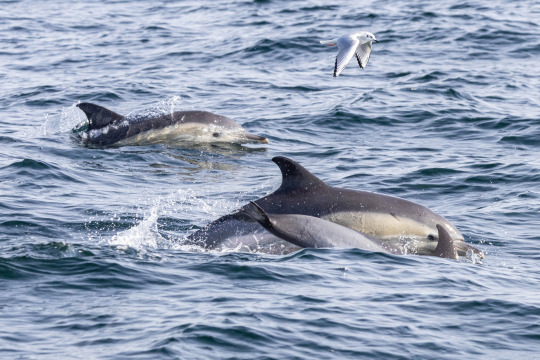
Short-beaked common dolphin Delphinus delphis
With Bonaparte's gull Chroiocephalus philadelphia
Observed by joshuamalbin, CC BY-NC
#Delphinus delphis#short-beaked common dolphin#Cetacea#Delphinidae#cetacean#dolphin#non-ungulate#bird#charadriiform#Chroiocephalus philadelphia#Bonaparte's gull#North America#United States#New Jersey#Atlantic Ocean#New York Bight
37 notes
·
View notes
Text
Last weekend I was planning to drive out to the west side to pick up a load of birdseed. My coworker had told me that he was out at Tiedeman's Pond the other day, and I said to myself, "I bet there's ducks on that pond. I better go check." So I grabbed my camera bag on the way out the door. And folks? There were ducks.
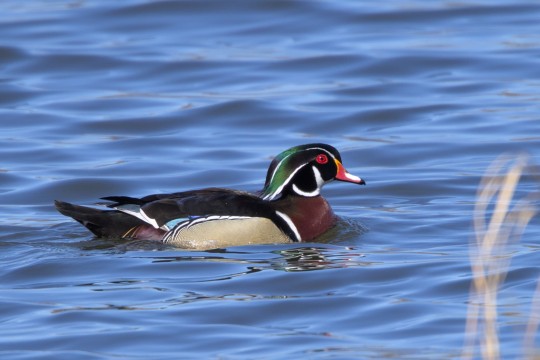
[ID: A male Wood Duck swims on a pond of rippling blue water from left to right. The duck is presenting his entire profile to the camera, from glossy green head to dark tail tip. He has a brown body, more burgundy at the breast, with finely scaled tan and gray flanks and just a hint of teal peeking through on the wing. Each color patch is bordered with a brilliant white stripe, including a lovely pattern on the face and head. His head feathers are swept back in a longish crest that looks black except for the iridescent green where the sun has caught it. This contrasts with a striking bill in orange gradients with a white patch on top and black tip. His eye is a bold fire engine red. End ID]
I was surprised to find multiple pairs of Wood Ducks very close to the edge of the pond, because these guys will usually fly at the first sign of a human in the area. I can only assume they were desensitized by the frequent groups of walkers out with their kids and their dogs.
There were lots of other ducks to be seen: Lesser Scaups, Hooded Mergansers, Buffleheads, Ruddy Ducks, Mallards. But most of these were way out at the center of the pond and not interested in being photographed. The only exception being a small group of Ring-necked Ducks that were diving for food near the cattails.
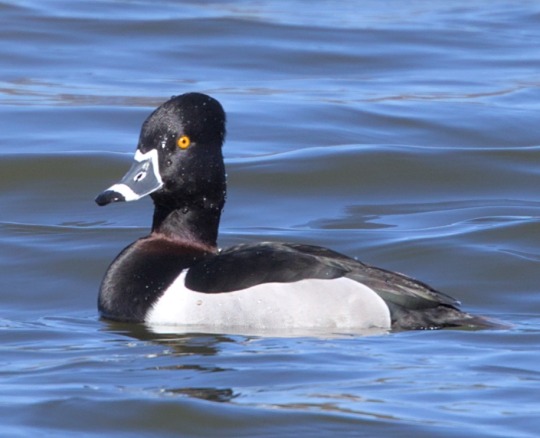
[ID: A male Ring-necked Duck swims from right to left on the pond. It is glossy black, with light gray flanks fading to white towards the front. His bill is medium gray in the middle, black on the tip, with a bright white border around the edges, circling the nostrils, and separating gray from black. His eye is yellow orange. His feathers are beaded with water droplets from diving for food. End ID]
But it wasn't just ducks on offer that day! Spring means birds migrating back from the south and hungry from the long flight. I got to watch a pair of Great Blue Herons show up and immediately begin hunting.
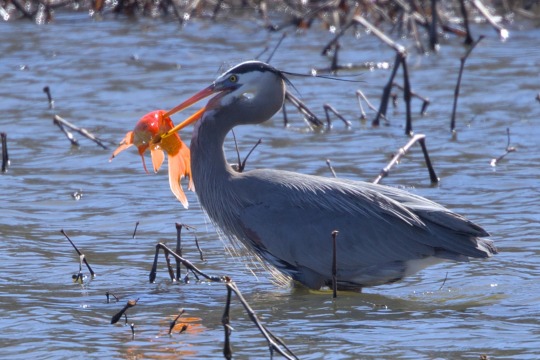
[ID: A Great Blue Heron is standing in a pond, with a freshly-caught goldfish in its bill. The Heron is standing with its legs completely submerged in the water, with its long neck coiled back as it pulls up the large goldfish. The Heron is several feet tall, mostly gray, with white on their head and a dark blue cap with long trailing feathers at the back. The goldfish is at least eight inches long, and the Heron appears to have speared it on their long upper mandible, which glows orange from the bright sunlight filtering through from behind. End ID]
I was very happy to see that the Herons were doing their part to control the non-native fish population. This one had speared a very large goldfish, and had to think a minute about how to eat it. They dropped the goldfish back in the water only to recapture it for swallowing head-first. Their partner looked on from a short distance away, not having found anything while I was there.
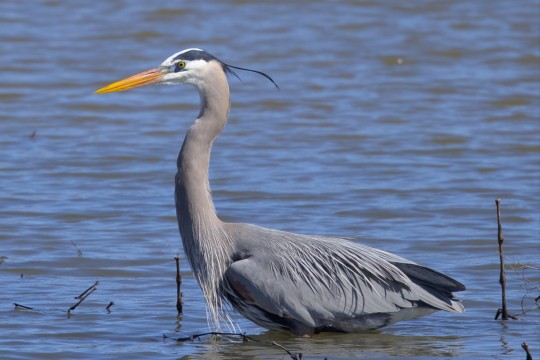
[ID: A second Great Blue Heron slowly wades by, hunting in the shallow part of the pond. This one shows a flash of dark-blue tail feathers, and the direct sunlight offers a nice view of their bright yellow dagger of a bill and their pale yellow eye rimmed in baby blue skin. End ID]
And it wasn't just water birds that were attracted to the awakening pond. This American Crow flew down to the edge to see what small morsels might be crawling around in the mud.

[ID: An American Crow stands at the edge of the pond. The Crow is facing away from the camera, with the sunlight glinting off their glossy black feathers. They are looking toward the camera in profile, showing one brown eye and a chunky black bill. End ID]
The Black-capped Chickadees were out too. This pair had found a nice little tree cavity, and they may have been excavating it further to use as a nest.

[ID: A Black-capped Chickadee peeks out from a tree hollow, holding a small bit of something in their bill. They are just a couple inches tall, with a gray and tan body, and a predominantly black head. They have white cheeks that start at the small black bill and extend back to the neck. They are staring inquisitively at the camera, with little bits of what looks like wood stuck to their face. End ID]
The two Chickadees seemed to be working in shifts, one keeping watch outside while the other one went in to prep the house. I wonder how many generations of birds have grown up in that little knothole...
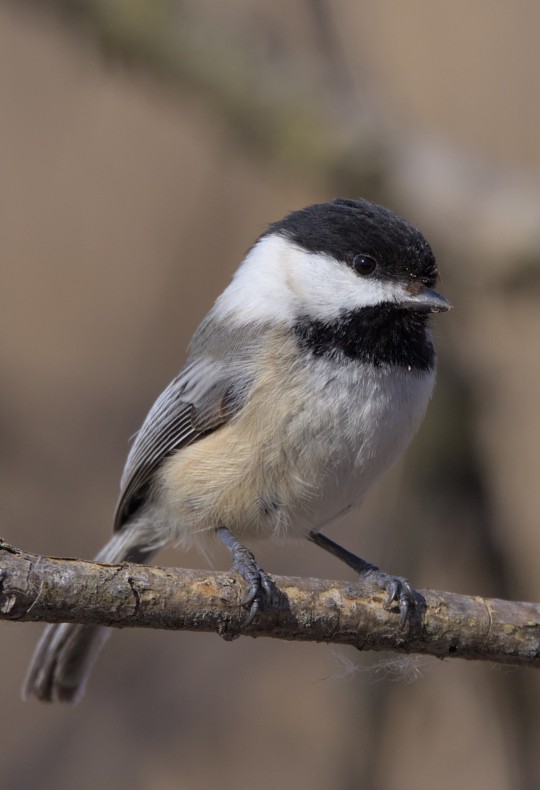
[ID: A second Black-capped Chickadee perches on a thin branch with delicate feet. They are sitting very still, keeping watch while their partner works in a nearby tree cavity. There are a few tiny flecks of what might be wood on their face. End ID]
Though, the bird that gave me the most excitement on this walk was a new one. My partner teases me, saying that I have to check every seagull to see whether they're a Herring or a Ring-billed. But on this day I had found a Bonaparte's Gull!
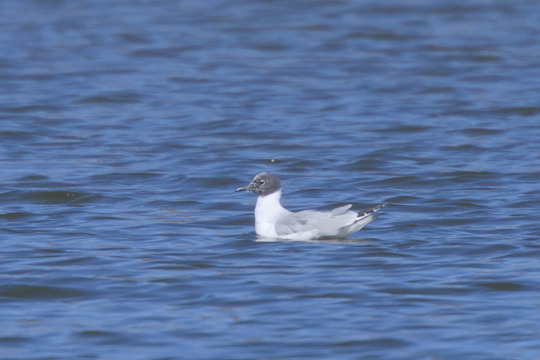
[ID: A Bonaparte's Gull floats out in the middle of the pond. The Gull is white with light gray wings and black wingtips. Their head is mostly gray with patches of white, possibly because they're in the middle of molting to grow their breeding plumage. End ID]
The Gull was hanging out with a nice flock of Lesser Scaups, and I knew I had a lifer in my binoculars as soon as I saw that gray head. Every so often it would take off and fly around the pond, looking for tasty fish to snatch from the surface. They never wandered all that close to me, but I got a few nice shots of those wings.
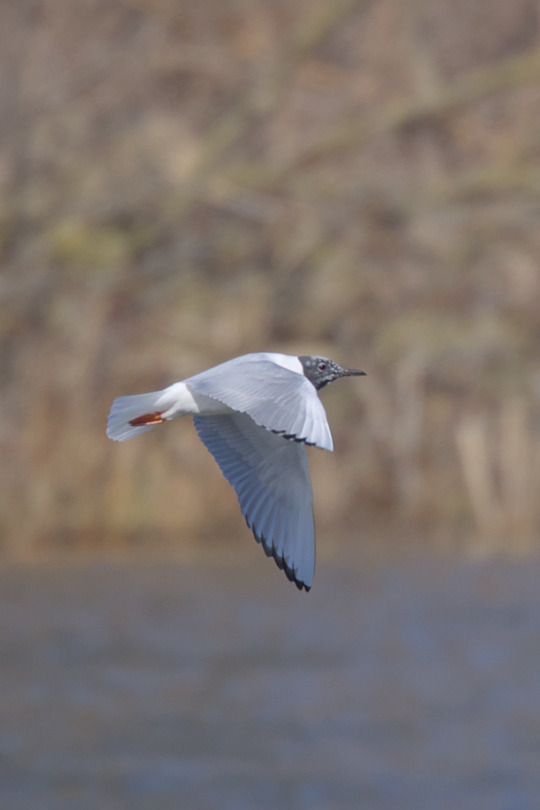
[ID: The Bonaparte's Gull flies low over the pond, on the hunt for small fish. With wings fully extended, it is apparent that the black wingtips are just a thin crescent at the tip of each primary flight feathers. The Gull is in the middle of a down stroke, head forward, orange feet tucked neatly beneath fanned gray tail. End ID]
For only visiting on a whim, this was a very productive walk. I saw 35 bird species, seven for the first time this year, and one for the first time ever. I suppose that's why birders wait all year for spring migration to start.
#bird#bird photography#birding#photography#birds#birdblr#birdlife#birdwatching#original photography#original photography on tumblr#duck#heron#gull#wood duck#ring-necked duck#great blue heron#american crow#black capped chickadee#bonaparte's gull#lifer
29 notes
·
View notes
Text
Juveniles
August 22, 2024

Juvenile California Gull
Now that most of the local Olympic Gulls are out of their nests, scattered along beaches, docks and alleyways, I think it would be a good time to talk about juvenile plumages. I would also like to briefly explore the types of moult that young birds undergo in early life, particularly in their first year.
Juvenile Plumage
Nestlings in most species begin replacing their natal down in the nest in a process called prejuvenile moult, which results in juvenile plumage.* Juvenile plumages (and subsequent immature plumages, like those of larger land birds and gulls) are fascinating, fine-tuned to give a young bird the best chance of survival. Thrushes like American Robins are speckled with dots and teardrop patterns to confuse a chasing predator, while the muted grey and brown colourations of Larus gulls act as camouflage. In fact, as for adult birds, juvenile plumages serve multiple and often conflicting functions (e.g. predator confusion vs camouflage), which find balance through natural and sexual selection.1

Fledgling Swainson's Thrush. Notice the buff teardrops on the upperparts and speckled chest.
Formative Plumage
There is also a wide variety of moult strategies for immature birds. In most cases, juvenile feathers have to grow quickly, being semi-functional by the time the bird has left the nest. Because of this, these feathers are of lower quality than adult feathers. Combined that with the fact that most species have a longer delay between prejuvenile (first prebasic) and second prebasic moult than subsequent moults, many species have supplemental moults to maintain feather quality.2 The preformative moult takes place after, or even before, the prejuvenile moult has completed, producing formative plumage. In many songbirds, and small gulls like Bonaparte's and Franklin's Gull, this moult is limited to body feathers and some coverts, though there is much variation.

First cycle Franklin's Gull. This individual has some grey feathers appearing on its upperparts, marking the start of the preformative moult.
Alternate Plumage
Larger gulls (Glaucous-winged Gull, Herring Gull, Ring-billed Gull, etc.) do not have a preformative moult.** Whereas the prebasic moult is usually complete (replacing body and flight feathers) and coincides with the nonbreeding season, the prealternate moult replaces less feathers. Alternate plumage--think of it as alternating with basic plumage annually--is completed around the breeding season for many species, and is often when you see birds at their most colourful. Birds that take multiple years to reach adulthood still undergo this prealternate "prebreeding" moult--it just looks a little messy. When my local Olympic Gull Juveniles start developing grey feathers on their backs, that is the prealternate moult in progress.

First cycle Ring-billed Gull beginning its prealternate moult (light grey on upperparts).
I know I am throwing a lot of jargon around--moults, cycles and bears, oh my! If anything, this is just me, a novice birder, trying to express my excitement about such misunderstood and under appreciated subjects as the plumages of juvenile and immature birds and the process of moult in general.
Until next time.
*I might confuse a few people writing about H-P terminology and the WRP system in Canadian English. Hopefully more Old World articles begin to be written using these standards, trading in Life Cycle terminology, which has an initially shallow learning curve, with that which better accounts for eclipse plumages in ducks and variation in moult duration in neotropical birds.3
**Preformative moults actually occur in most birds, according to Pyle. However, it is not appreciable enough in the larus gulls I come across. I need to look into this further.
References
Jenni, Lukas, and Raffael Winkler. “The Biology of Moult in Birds.” Bloomsbury Publishing, 2020, pp. 10.
Pyle, Peter. “Identification Guide to North American Birds.” Part 1, Second Edition, Slate Creek Press, California, 2022, pp 16.
Wolfe, Jared D, et al. “Ecological and evolutionary significance of molt in lowland Neotropical landbirds.” Ornithology, Volume 138, Issue 1, 2021. doi.org/10.1093/ornithology/ukaa073
#birding#birds#birdwatching#gulls#larus#bc#canada#glaucous-winged gull#larusglaucescens#larusoccidentalis#franklins gull#bonapartes gull#molt#moult#plumage
13 notes
·
View notes
Text

Bonaparte's Gull Chroicocephalus philadelphia
11/23/2021 Santa Cruz, California
#bird#birds#bird photography#birdblr#birding#birding photos#bird watching#bird photos#my photos#bonaparte's gull#gull#gulls#seagull#wildlife#nature#wildlife photography
11 notes
·
View notes
Text



Non breeding Bonaparte’s gulls
(8/11/24)
8 notes
·
View notes
Text
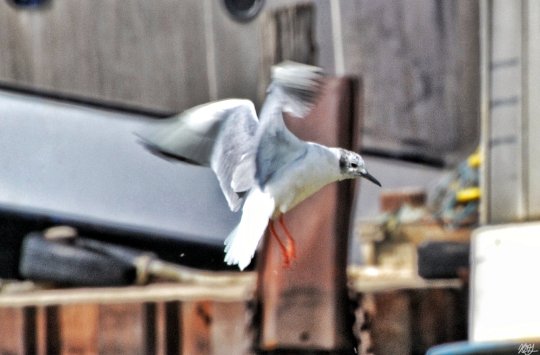
Bonaparte's Gull
#ontario#original photographers#nature#nature photography#beautiful#bird photography#birdblr#walking in nature#birding#birds of north america#bird watching#bird#birds#birdwatching#gull#bonaparte's gull#photographer#photography#female photographers#landscape photography#nature photo art#photographers on tumblr#original photography on tumblr#nikonphotography#nikon
11 notes
·
View notes
Text

daily bird calendar bird of the week
February 12th - February 18th, 2024
Bonaparte's Gull | February 17th/18th, 2024 Our smallest commonly seen gull; differs from terns by broader wings, shorter bil, and details of plumage, often swims and rarely hovers. Note thin black bill, pink to red legs, and white outer primaries.
7 notes
·
View notes
Text
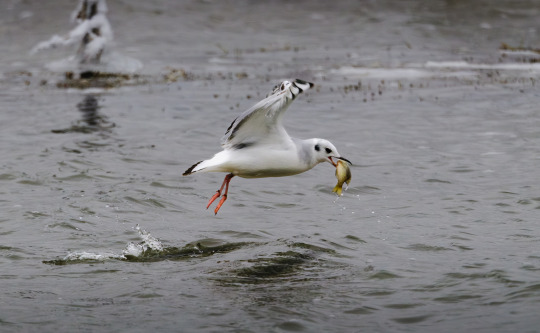
Bonaparte's Gull
#photography#fujifilm#austin#texas#x-h2#fujifilm x h2#nature#birds#birding#bird photography#birdwatching#gull#bonapartes gull#ice#fishing#fish#bird pics#birdblr#birbs#bird watching#bird
4 notes
·
View notes
Text

Bonaparte’s Gull <3
#birds#original photography on tumblr#Bonaparte’s gull#gulls#nature#vancouver island#nature photography#pnw#birding#bird photography#birdwatching#queue
36 notes
·
View notes
Text
Round 2, Side B: Match 31


[Image ID: Two pictures of gulls. The left is an ivory gull walking across sand with its head lowered. The right is a Bonaparte's gull walking across mud with its head lowered. /End ID]
The ivory gull (Pagophila eburnea) is a mid-sized gull that has a circumpolar distribution around the Arctic. They typically measure 40-43 cm (16-17 in) in length and 108-120 cm (42-47 in) in wingspan. They have a more pigeon-like shape than other gulls. Their plumage are completely white, and they have black legs and a thick blue bill with yellow tip. They feed on fish, crustaceans, rodents, eggs, and small chicks. They have been known to follow polar bears and other predators to scavenge on the remains of their kills. Because of their declining population, possibly due to illegal hunting or to decline in sea ice, they are listed as near threatened by the IUCN.
The Bonaparte's gull (Chroicocephalus philadelphia) breeds in northern North America and migrates to winter farther south. At 28-38 cm (11-15 in) in length and 76-84 cm (30-33 in) in wingspan, it is the third smallest gull. They have white underparts, grey upperparts and wings with black tips, black head, white eye-crescents, orange-red legs, and black short, thin bill. They feed mainly on insects, as well as eggs of spawning salmon, small crustaceans and molluscs, and steal food from other birds.
ivory gull image by Alan Vernon
Bonaparte's gull image by Len Blumin
3 notes
·
View notes
Text
Bonaparte's Gull in Provincetown 05/07/24

View On WordPress
0 notes
Text
In search of an American Bonaparte

View On WordPress
0 notes
Text


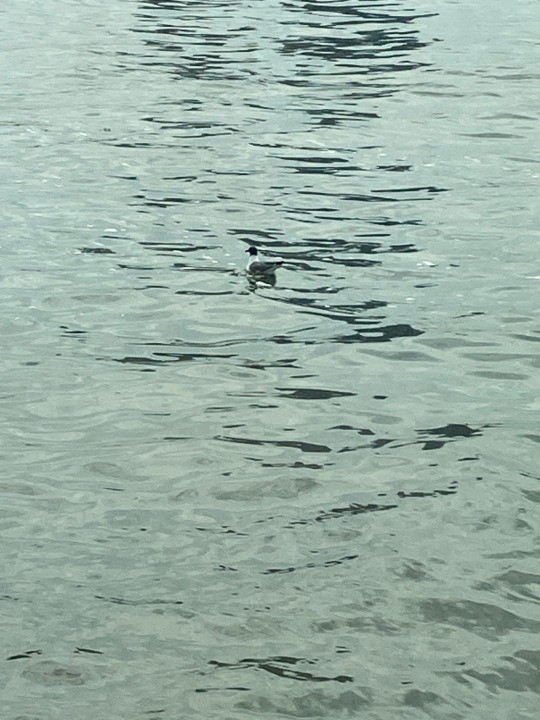
1 note
·
View note
